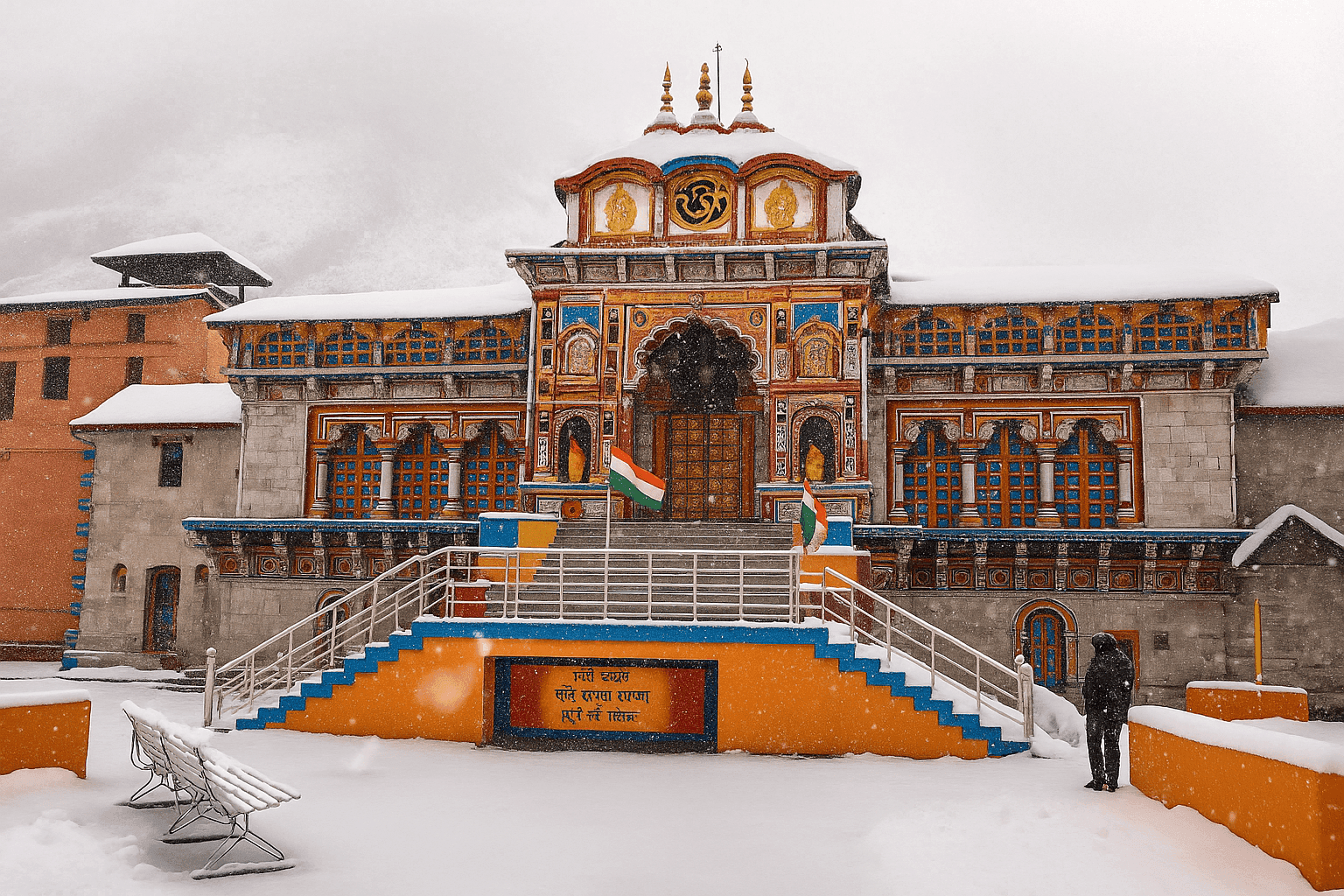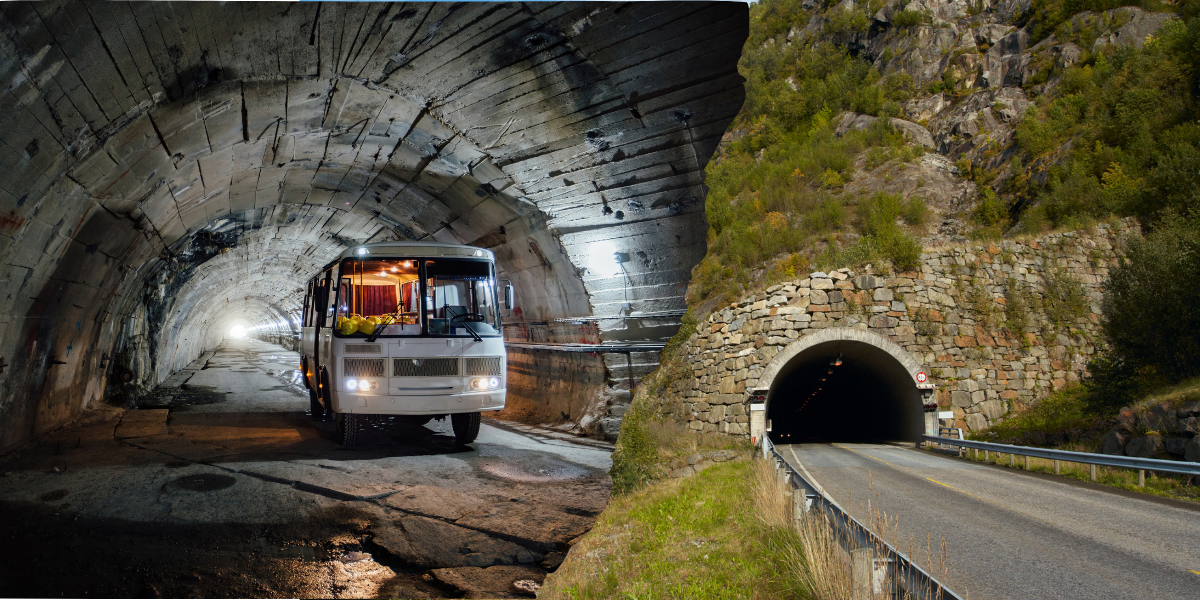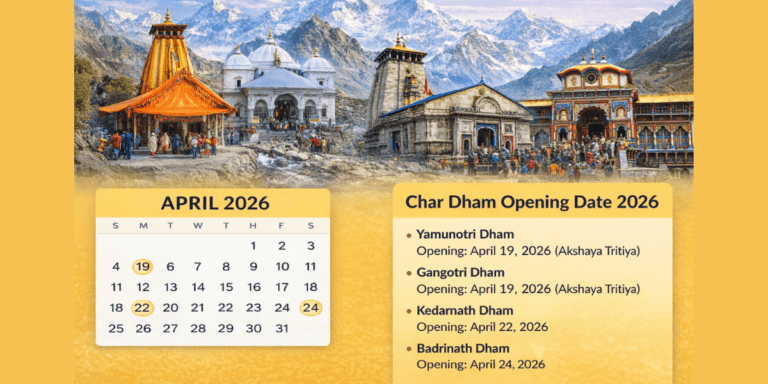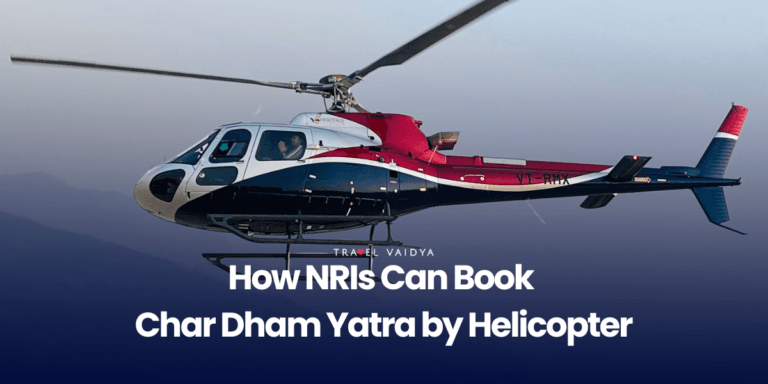Yes, snow in Badrinath is real and it’s heavy. From late November to early March, the entire region is buried under thick layers of snow, with temperatures often dipping to -5°C to -15°C and the temple stays closed during this period. Roads often get blocked, and travel isn’t recommended in peak winter. If you’re hoping to see snowfall in Badrinath, plan your trip around late September to early November, that’s when fresh snow begins and the temple is still open. Snow adds charm, but it also means freezing temperatures and limited access. Dress warm, check road conditions, and avoid winter visits with small kids or elders.
Table of Contents
Does Badrinath Get Snowfall Every Year? What Families Should Know
Yes, Badrinath gets snowfall every year, starts from late November to March. Due to its high elevation, the region experiences moderate to heavy snow, especially between December and February. Shree Badrinath Temple closes around mid-November, after which road access becomes limited or completely blocked. Snowfall often starts in the last week of November, with freezing temperatures ranging from -5°C to -15°C during peak winter. As the area shuts down for winter after temple closure, no tourist movement is allowed beyond a certain point. If you want to experience snow in Badrinath while still being able to visit, the best window is late September to early November—before roads close.
- Annual snowfall: Late November to March
- Peak snow months: December to February
- Temple closes: Mid-November
- Roads blocked post mid-November
- Best time to see snow: Late September to early November
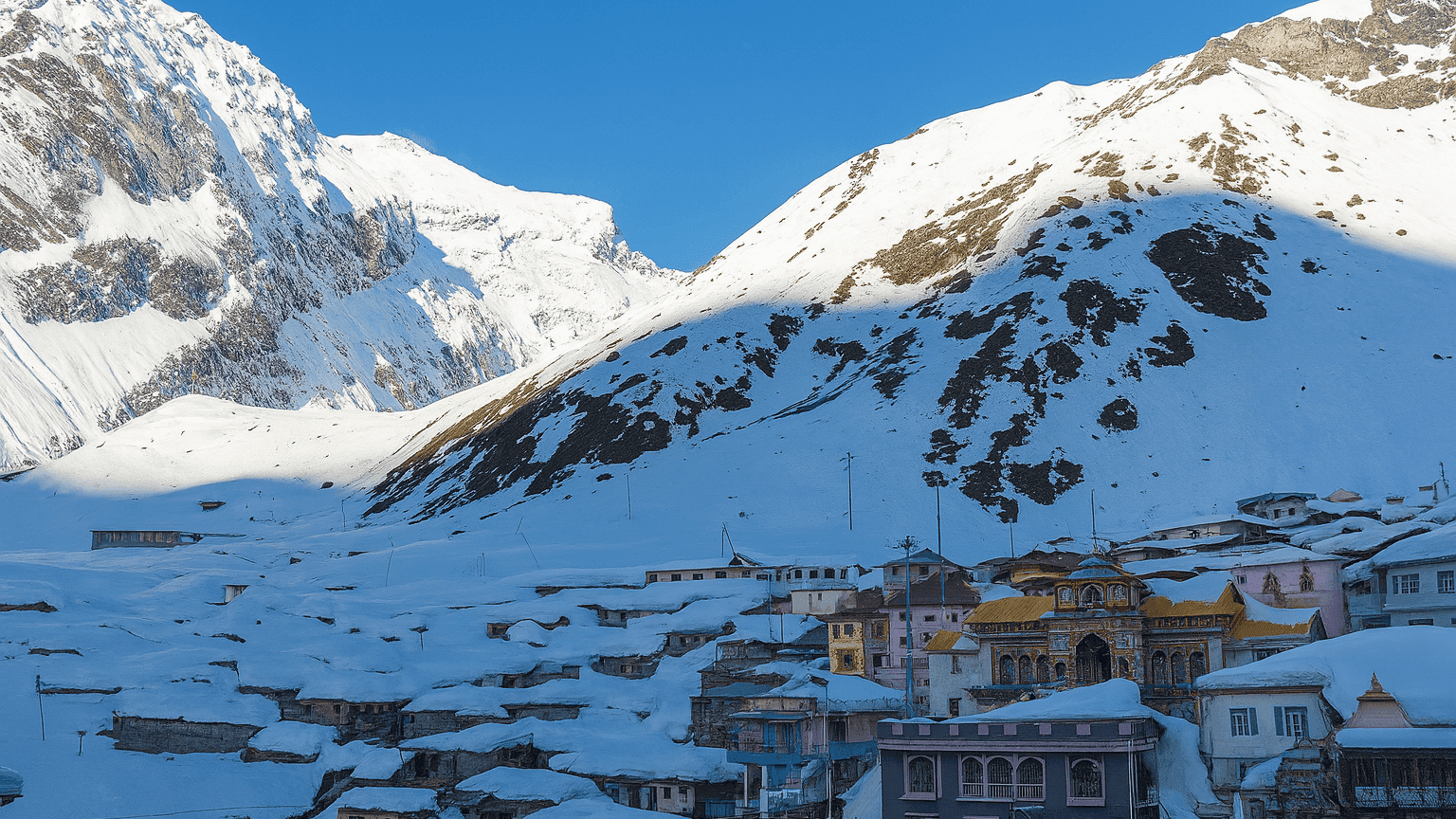
When Does Snowfall in Badrinath Begin and How Long Does It Last?
Snowfall in Badrinath usually begins in the last week of November and continues till early April. The heaviest snow is recorded from December to February, with temperatures often falling below -10°C. The temple shuts by mid-November, and roads become risky soon after.
- Snowfall season: Late November to early April
- Peak snow period: December to February
- Temple closes: Mid-November
- Extreme cold and blocked roads after mid-December
Is It Safe to Visit Badrinath During Snowfall With Kids or Elders?
Visiting Badrinath during snowfall is not recommended for families with small kids or elderly members. Freezing temperatures, slippery terrain, and limited emergency services make winter travel unsafe. January is the harshest month, and most routes remain blocked or inaccessible. For a safer experience, avoid the deep winter months and plan your visit before mid-November if travelling with vulnerable family members.
- Not ideal for kids or elders during snowfall
- January is the coldest month, often below -10°C
- Medical and transport support is limited
- Road closures are frequent after mid-November
- Safer to visit before heavy snowfall begins
What Is the Best Time to See Snow in Badrinath?
The best time to see snow in Badrinath is from the last week of September to early November, just before the temple closes and road access becomes limited. Light snowfall often begins by late October, offering snow views while the region is still open to tourists. After mid-December, snowfall increases, temperatures drop sharply, and most routes become blocked or unsafe.
- Ideal snow window: Last week of September to early November
- Temple closes: Around the first or second week of November
- Initial snowfall begins in late September
- Roads remain accessible until early November
- Heavy snow blocks access from mid-November onwards
Quick Routes to Badrinath Before Snow Hits
Badrinath Yatra from New Delhi
Badrinath Yatra from Dehradun
Badrinath Yatra from Haridwar
Badrinath Yatra from Rishikesh
How Cold Does It Get During Snowfall In Badrinath?
During the snowfall months, Badrinath experiences extreme cold, especially from late November to February. Daytime temperatures usually range from -2°C to 5°C, while nighttime temperatures often fall below -10°C. The cold is intensified by high wind chill, and even early mornings and evenings can feel freezing. Sunrise in winter is generally around 7:00 AM, and sunset by 5:00 PM, giving very short daylight hours. Snow begins to settle by late September, and by December thick snow covers the region. The cold is harsh, and without proper gear like thermals, heavy jackets, gloves, and insulated shoes, movement becomes difficult. Electricity, water supply, and mobile networks may also be limited during peak winter.
- Daytime: -2°C to 5°C
- Nighttime: Drops to -10°C or lower
- Sunrise around 7:00 AM, sunset by 5:00 PM
- Heavy wind chill adds to the cold
- Proper winter gear is mandatory (thermals, jackets, gloves, etc.)
What Are the Road Conditions Like During Snow in Badrinath?
Roads become unsafe and often close by mid to late November due to heavy snow in Badrinath. The BRO(Border Roads Organisation) restricts access beyond Joshimath for safety. Roads are slippery, prone to landslides, and travel is slow. Public transport stops, and private vehicles are not allowed after closures. Always check BRO and weather updates before planning a trip.
- Roads usually close by mid to late November
- Slippery and landslide-prone stretches after snowfall
- No public or private transport allowed beyond closure points
- BRO issues travel restrictions based on weather
- Always check road conditions in advance
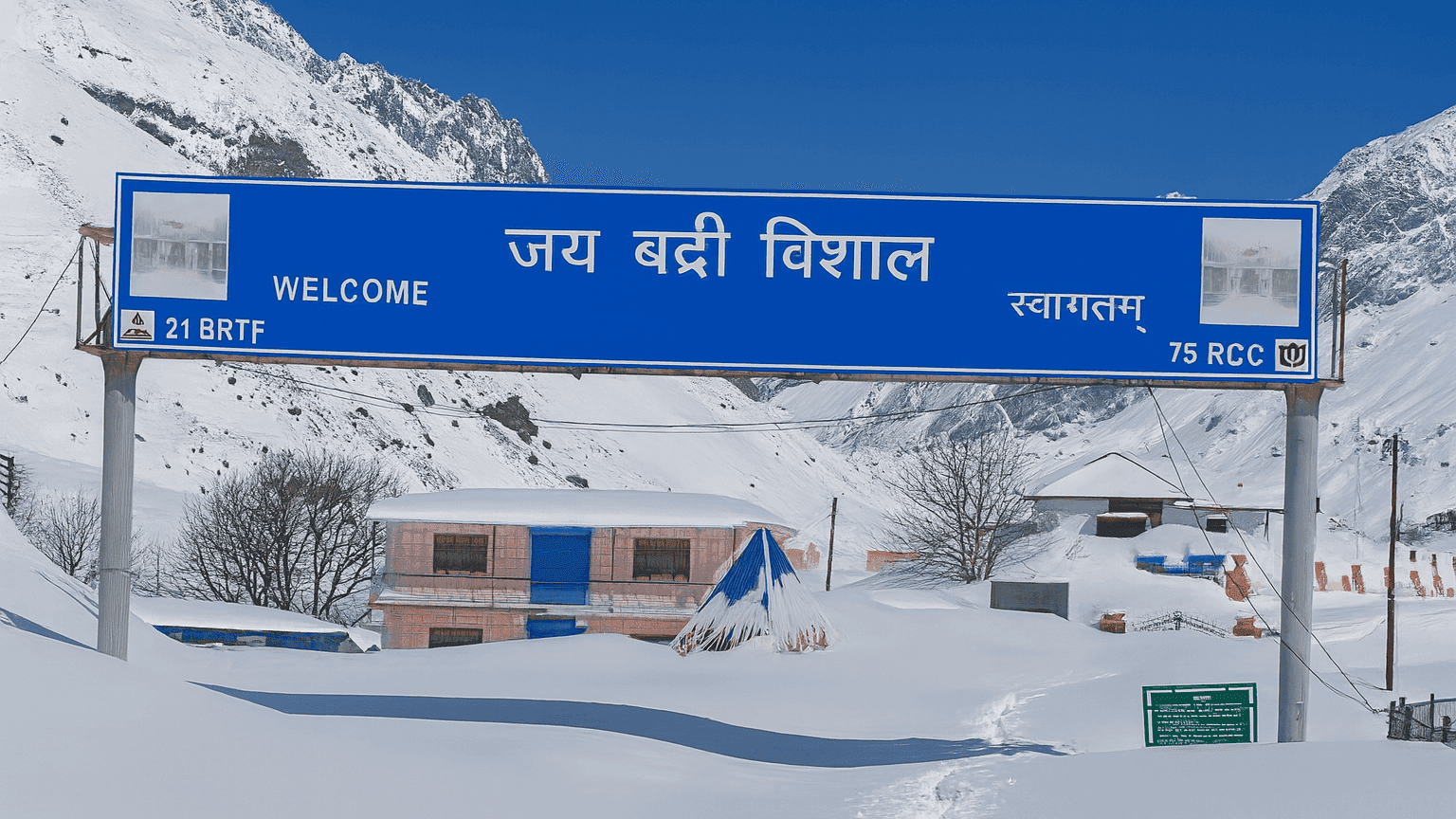
Is Badrinath Temple Open During Snowy Weather?
No, Temple is closed during snow in Badrinath. The temple closes every year around mid-November, usually just after Diwali, before heavy snowfall begins. Once closed, no darshan is possible until it reopens in April or May, depending on the Hindu calendar and weather conditions. Hotels and shops also shut down for the winter. Always check official closure dates if planning a visit near the season’s end.
- Check official dates before planning
- Temple closes: Mid-November (post-Diwali)
- Reopens: April–May every year
- No darshan during snowfall months
- Hotels and local services remain shut
Can Tourists Visit Badrinath in Peak Winter Months?
No, tourists cannot visit Badrinath during peak winter months. From December to March, the area is officially closed due to heavy snowfall and unsafe road conditions. Access is restricted beyond certain checkpoints, and all hotels, shops, and temple services remain shut. Only local residents, BRO staff, or emergency personnel stay in the region during this time. For snow views with access, plan your trip before mid-November.
- No tourist access from December to March
- Region is officially closed after heavy snowfall
- Hotels and shops shut completely
- Only locals and authorities remain
- Best time to visit is before mid-November
How Much Snowfall Does Badrinath Receive in December and January?
Badrinath receives 3 to 6 feet of snowfall in December and January, covering the entire region in deep snow. Temperatures stay below 0°C, often dropping to -10°C or lower. Roads are fully blocked, the temple is closed, and tourist entry is not allowed during this time.
- Heavy snowfall: Up to 3–6 feet
- Temperature: -5°C to -10°C or lower
- Roads blocked and no public access
- Temple and hotels remain closed
- Tourist visits not permitted in peak winter
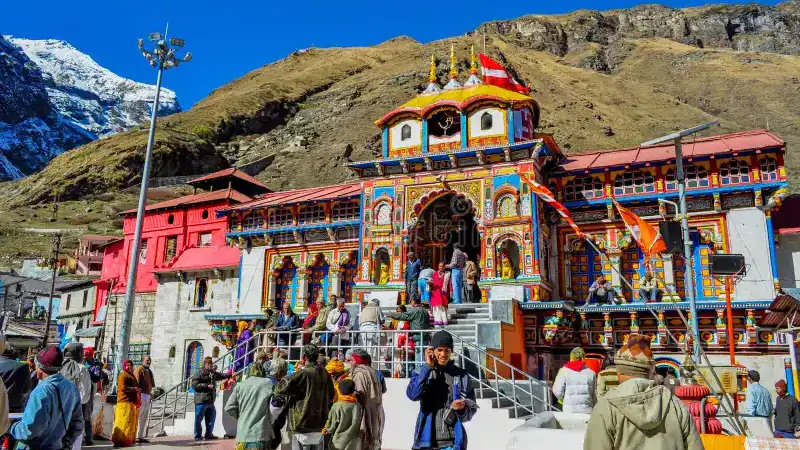
Are There Non-Snowy Months That Are Still Good for a Peaceful Visit?
Yes, September to early November is a great time to visit Badrinath without snow. The weather is cool and dry, roads are fully open, and the temple remains operational until mid-November. While it’s mostly snow-free, occasional light snowfall can occur in early November if temperatures drop sharply, but it’s usually not enough to block access or affect travel.
- Best non-snowy window: September to early November
- Temple remains open until mid-November
- Roads are clear and safe for travel
- Temperatures: 5°C to 10°C (can drop at night)
- Light snow may occur in early November, but not heavy enough to block roads
Badrinath Temple Tours
Haridwar to Badrinath Temple Tour – 3 Days
Temple Darshan & nearby sightseeing – ideal for a families Y seniors.
Dehradun to Badrinath Temple Tour – 3 Days
Dehradun to Badrinath tour covering food, hotels, and travel.
Delhi to Badrinath Temple Tour – 5 Days
Family-friendly Badrinath Temple tour with safe stays and local drivers.
Rishikesh to Badrinath Temple Tour – 3 Days
Easy Badrinath darshan tour with all arrangements done.
What to Pack for Badrinath in Snow Season – Especially for Children and Seniors
Traveling to Badrinath during the snow season requires careful packing, especially if you’re with kids or elderly family members. The weather is harsh, so staying warm and comfortable is key. Focus on proper winter layers, essential medicines, and safe footwear for slippery paths.
- Warm layers: thermals, jackets, gloves, woolen caps, mufflers
- Cold and altitude sickness medicines, basic first-aid
- Moisturiser, lip balm, sunscreen for dry skin and sun exposure
- Anti-slip waterproof shoes with good grip
- Extra socks and a blanket or shawl for added warmth
Are Medical Facilities Available in Badrinath During Winter?
Medical facilities in Badrinath are very limited during winter months (December to March). After the temple closes around mid-November, most health posts and support services also shut down. If you travel before the closure in September or October, basic medical help is available through local health centers. However, for any serious issues, the nearest hospital is in Joshimath (approx. 45 km). During heavy snow season, even reaching Joshimath can be difficult. Always carry essential medicines, first-aid, and altitude-related medication, especially for children or elders.
- Medical help available only until mid-November
- Post-closure (Dec–Mar): No active medical support in Badrinath
- Nearest hospital: Joshimath
- Travel before Nov for better access to basic care
- Carry all personal and emergency medicines
What Are the Stay Options During Snow Season in Badrinath?
Accommodation in Badrinath is unavailable during the snow season. Most hotels and guesthouses close by mid-November, along with the temple. After that, there are no stay options in Badrinath due to extreme cold, lack of heating, and no running water. If you’re visiting before mid-November, book in advance. During peak winter (December to March), the nearest place to stay is Joshimath.
- Hotels shut by mid-November
- No stay options in Badrinath from December to March
- No heating or water supply in peak winter
- Stay in Joshimath during snow season
- Book early if visiting before closure
Must Read: Best Senior Friendly Hotels in Badrinath for Families
Tips for Traveling With Kids and Elderly to Badrinath in Snowfall Season
Traveling to Badrinath during the snowfall season (late October to mid-November) with kids or elderly family members requires careful planning. The weather of Badrinath is unpredictable, and even mild snowfall can quickly turn into roadblocks or health issues. While travel is allowed until temple closure, comfort and safety should be the priority. Here’s how to make the trip smoother:
Helpful Tips:
- Travel before mid-November: After this, temperatures drop sharply and access is restricted.
- Break the journey: Stay overnight in places like Joshimath to avoid fatigue and adjust to altitude.
- Pack extra layers: Don’t rely on one jacket. Use thermal inners, fleece, and a windproof outer layer.
- Use insulated, non-slip footwear: Roads and temple steps can get icy and dangerous.
- Keep hands and ears covered at all times to avoid frostbite or sudden chills.
- Stay hydrated and eat light: Cold weather reduces thirst, but dehydration increases risk of altitude sickness.
- Carry portable oxygen cans if any family member has a respiratory or heart condition.
- Avoid early morning or late evening movement: Travel between 10 AM and 4 PM when it’s slightly warmer.
- Book hotels with reliable heating and running water: Many smaller lodges shut down utilities early.
- Watch for altitude sickness symptoms: Dizziness, headache, nausea—rest and descend if these appear.
- Have basic medicines and ORS ready, especially for children with sensitive stomachs or elders on regular meds.
- Stay flexible: Be ready to change plans if roads close or the weather turns bad.
Which Routes to Badrinath Remain Open During Snowfall?
During snowfall months (December to March), the route to Badrinath closes beyond certain points due to heavy snow and safety risks. The Joshimath to Badrinath stretch is the first to be blocked. Govindghat is usually the last accessible point, depending on snowfall. The Border Roads Organisation (BRO) keeps some stretches open for emergency and military use only, no public access is allowed to Badrinath town during this period.
- Joshimath–Badrinath route closes in peak winter
- Govindghat remains accessible, depending on snow
- BRO maintains limited access for emergencies only
- No entry for tourists beyond closure points
- All temple and town access shuts December to March
What Are the Risks of Altitude and Cold Weather for Seniors and Children?
Badrinath sits at an altitude of over 10,000 feet, where the air is thinner and oxygen levels are lower. Combined with sub-zero temperatures, this can pose serious health risks for children and elderly travelers. Common issues include Acute Mountain Sickness (AMS), breathing difficulty, headaches, fatigue, and in severe cold, risk of hypothermia. Early signs often go unnoticed, so careful monitoring is essential. It’s important to ascend gradually, stay warm, and keep hydrated.
- Altitude: 10,279 ft (3,133 m) — risk of low oxygen
- Common risks: AMS, breathlessness, nausea, hypothermia
- Stay warm and well-hydrated at all times
- Avoid physical exertion at high elevation
- Watch for early signs of discomfort, especially in kids and elders
Are There Snow Activities in or Around Badrinath for Families?
Badrinath itself does not offer any snow activities, as the temple closes by mid-November and the area becomes inaccessible in winter. There are no skiing, sledging, or guided snow experiences in or near the temple zone due to safety concerns. However, if you’re looking for family-friendly snow fun, head to Auli, located near Joshimath. Auli is a popular winter destination offering skiing, snowboarding, cable car rides, and gentle slopes suitable for kids and beginners.
- No snow activities in Badrinath due to temple closure and access issues
- Snow viewing possible before mid-November in Badrinath
- Auli (near Joshimath) offers skiing, snowboarding, and snow play
- Best time for Auli snow activities: Late December to February
- Ideal for families looking for safe and guided snow experiences
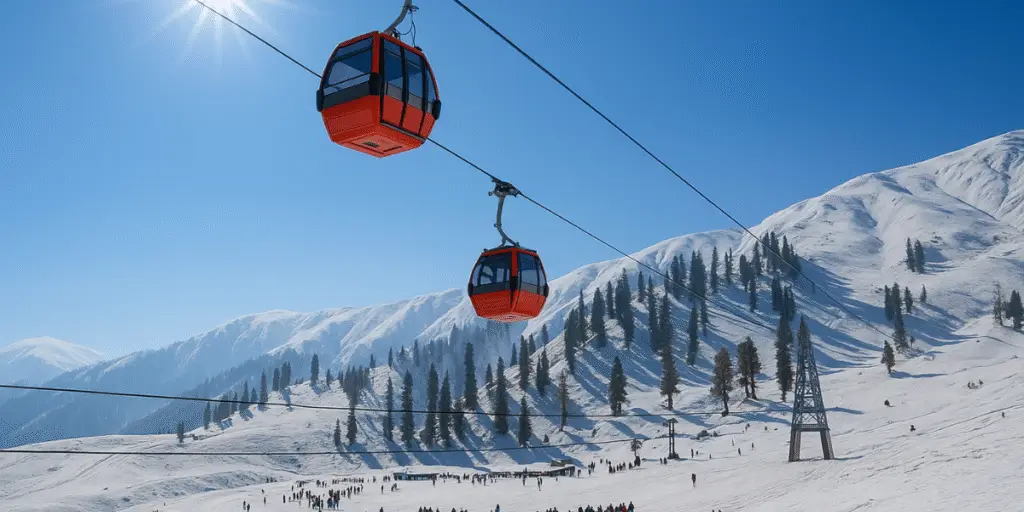
Nearby Snowy Places to Visit if Badrinath Is Closed
If Badrinath is closed due to snow, you can still enjoy the winter beauty of nearby spots with easier access and better facilities. Auli is the top alternative, offering skiing, snowboarding, and panoramic snow views. Joshimath, just below Auli, serves as a convenient base with good stay options and access to short winter trails. These locations remain open even in peak winter and are safer options for families.
- Auli: Popular for skiing, cable car rides, and snow play
- Joshimath: Good for snow views and short winter treks
- Both places remain accessible in peak winter
- Better infrastructure and stay options than Badrinath in snow season
- Ideal for a snow experience without travel restrictions
Should You Postpone Your Trip if Heavy Snowfall Is Predicted?
Yes, it’s best to postpone your trip to (May-June or Sep-Oct) if heavy snowfall is expected. In the Badrinath region, even light snow can lead to roadblocks, landslides, and sudden route closures. Conditions become unsafe very quickly, especially in high-altitude zones with limited facilities. However, if you’re planning your visit before the temple closes (around mid-November) and snow is still manageable, you can go ahead—but only after checking road and weather updates from BRO and local authorities.
- Postpone if heavy snow is predicted
- Snow can block roads without warning
- Travel is safer only until temple closure (usually mid-November)
- Always check BRO and weather updates
- Avoid risks in uncertain weather conditions
About Travel Vaidya – Trusted Travel Experts of Uttarakhand
Travel Vaidya is a Dehradun-based travel company with deep roots across Uttarakhand. For over 9 years, we’ve helped families, senior citizens, and spiritual travelers explore places like Char Dham, Auli, Jim Corbett, Nainital, Kausani, Almora, and Ranikhet with confidence.
We’re not a call center or big-brand OTA—we’re a small team that builds practical, experience-based itineraries. Every plan is shaped by local knowledge, seasonal awareness, and what actually works on-ground.
From temple visits to hotel check-ins, we handle logistics, route planning, and day-wise support—especially for elders and family travelers. We share what we know from living here, not from reading about it.
This guide is part of our effort to make travel in Uttarakhand easier to understand and plan.


